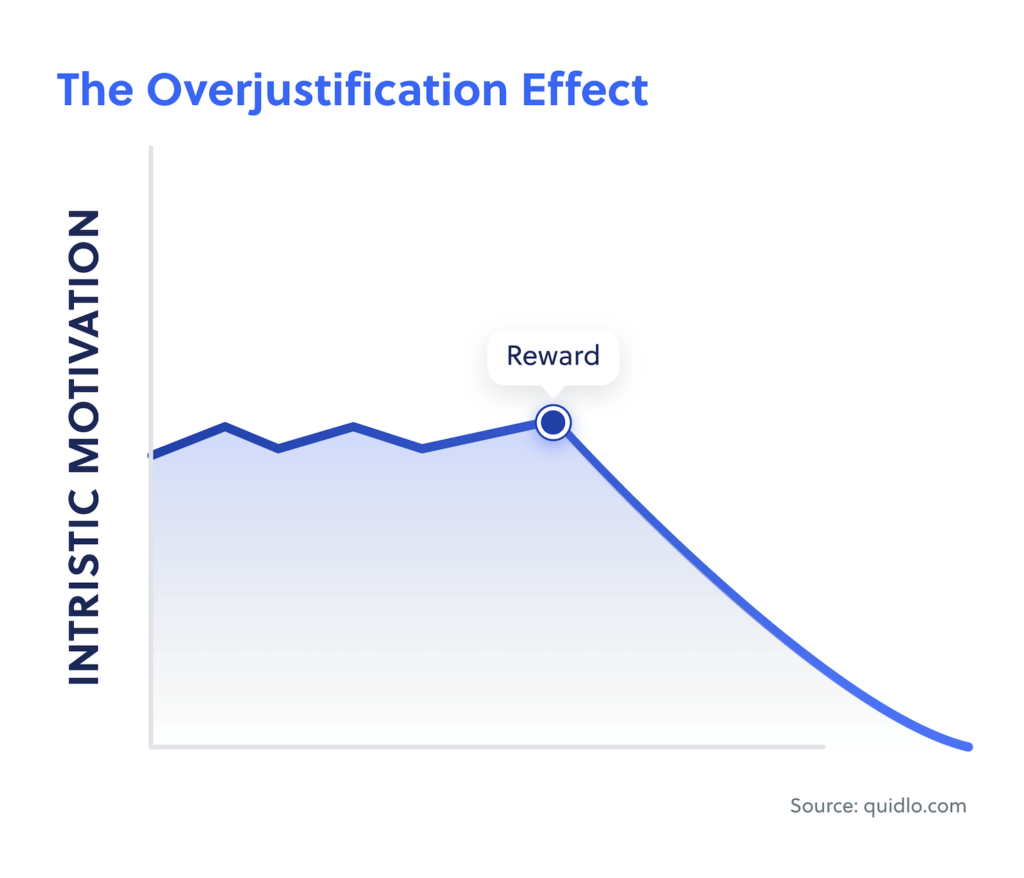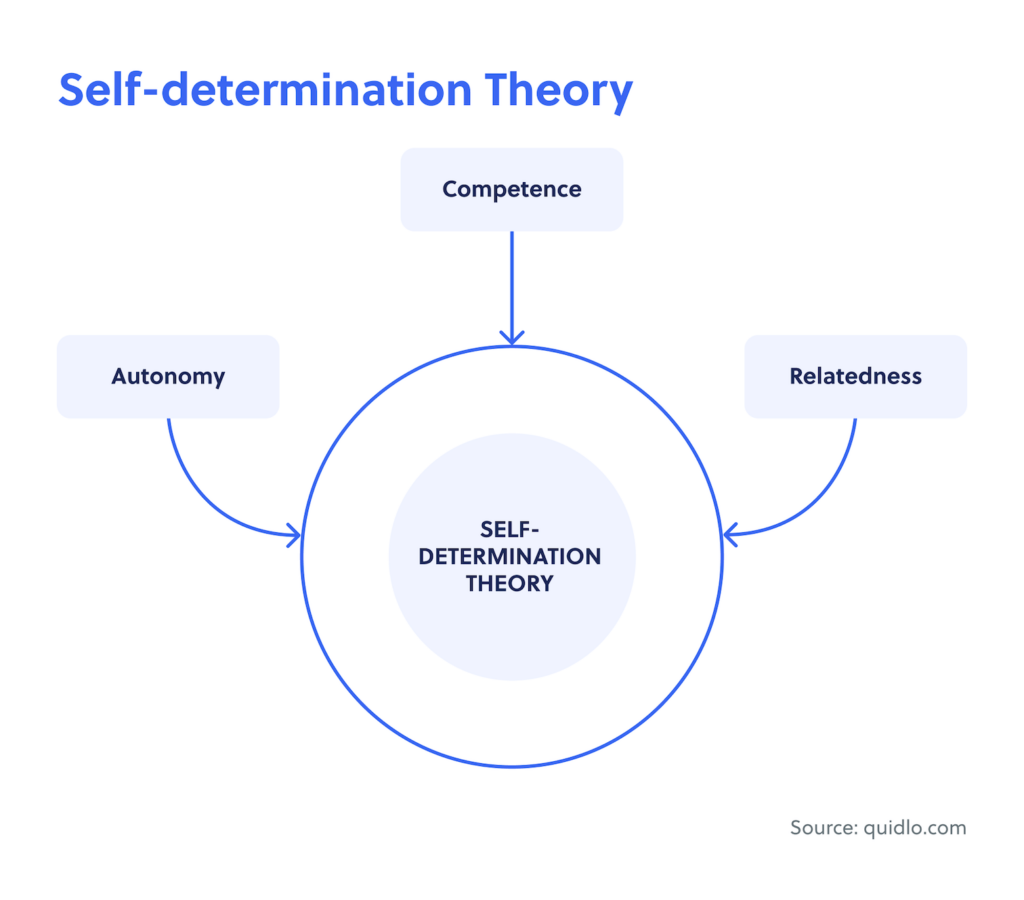Motivation is important in all aspects of society. In education, teachers encourage and motivate their students to complete their learning tasks; in the workplace, managers need their employees to keep motivated to make sure the momentum on projects is kept up; and in sports, players must be motivated to perform to the best of their abilities.
The power of motivation should not be overlooked. Properly motivated employees, for example, can generate more profit. Gallup’s State of the Global Workplace: 2022 Report found that teams that are highly motivated result in a 21% increase in business profitability.
However, if you’ve ever struggled with motivating yourself or someone around you, you’ll know that it is a difficult challenge to address. The key is to understand why people lose motivation and to prevent it from happening in the first place. One of the most prominent reasons for demotivation is the overjustification effect. Read on to learn more about it, real-world examples, and the causes.
Table of Contents
What is the overjustification effect?
The overjustification effect in psychology refers to when the introduction of an incentive has detrimental effects on an individual’s intrinsic motivation to complete a task that they were initially motivated to do alone.

In simple terms, the overjustification effect is when rewards like money, prizes, or social validation negatively affect the motivation a person had to do the task originally. To understand the overjustification effect, it is helpful to first understand the two primary types of motivation that drive human behavior: intrinsic and extrinsic motivation.
- Intrinsic motivation
Intrinsic motivation refers to a person’s desire to complete a specific behavior out of personal joy or interest. A good example is that of playing recreational sports. A person who does this as a hobby is motivated to do so out of their own enjoyment.
- Extrinsic motivation
Extrinsic motivation, on the other hand, is when an individual completes a behavior to achieve a particular outcome. An example of this type of motivation is when a child tidies their room because their parents will give them chocolate as a reward.
The overjustification effect was first formally recognized in 1971 by psychologist Edward Deci. Deci discovered the phenomenon while investigating the relationship between intrinsic and extrinsic motivation. In his experiment, he found that a group of university students were happy to complete a puzzle together for no particular purpose and with no supervision. Therefore demonstrating their intrinsic motivation.
Deci then gave the same students a financial incentive. In response, their motivation to complete the puzzle increased. However, when Deci removed the financial incentive, the students’ motivation significantly decreased to less than they began with.
Overjustification effect cause
Both intrinsic and extrinsic motivation are effective, however intrinsic is usually preferred. This is because it is longer-lasting and holds less risk of decreasing over time. When people are motivated to do a task out of their own enjoyment or interest, they are much more likely to stay motivated over time. Extrinsic motivation, however, is more at risk of being reduced dramatically as it is reliant on the incentives being provided each time. If the incentive is no longer available, the extrinsic motivation levels will drop.
The overjustification effect occurs when the two main types of motivators are mixed together. As discussed, intrinsic motivation can be incredibly powerful. Yet when extrinsic rewards are brought in, intrinsic motivation will suffer and the overjustification effect occurs.
This is demonstrated perfectly in Deci’s original study. To begin with, the students were motivated to complete the puzzle themselves. There was no reward for doing so, but they were happy to complete it out of their own inherent enjoyment. Although their extrinsic motivation increased when they were offered money for completing the puzzle, their intrinsic – and long-lasting motivation – suffered. Once the reward was taken away, they no longer felt compelled to complete the puzzle out of their own accord.
Overjustification effect examples
Despite the psychological research proving how detrimental the overjustification effect can be, it is actually embedded in many aspects of society and culture. You won’t have to look far to see the overjustification effect in action, as it is often standard practice for people to offer incentives to boost motivation. Despite the offer of an incentive coming from the best intentions, it is proven to have a negative effect in the long run.
The overjustification effect can be observed in everyday life and workplace examples that you may recognize.
Overjustification effect in everyday life
One general example of the overjustification effect in everyday life is that of artists and creators becoming detached and unmotivated towards their work after being paid for it. Here is an example of this in practice:
YouTuber overjustification effect example
An individual begins making fashion-themed YouTube videos. It’s her passion and she loves creating this content as fashion is her greatest hobby. She receives lots of positive comments and has great conversations with her viewers. This keeps her motivated to make more.
The YouTuber’s videos start doing really well. Her video views start going from hundreds of views to tens of thousands. As a result, she starts getting approached by brands who want to work with her to advertise their products. She starts working with the brands and now gets paid for each video she produces. This motivates her to create the videos even more, as she not only enjoys making them but is also receiving a financial reward.
After a few more months, the YouTuber notices that her video views have decreased by a lot. The trend for her kind of videos seems to have passed and the brands she previously worked with no longer want to advertise in her videos. Despite fashion videos being her biggest hobby, as she is no longer getting paid to make them, she finds that she is no longer enjoying making them. She feels incredibly unmotivated to create any new videos without the money coming in from brands. She decides to stop creating them altogether.
Parenting overjustification effect example
The overjustification effect is also commonplace in parenting techniques. Parents are often encouraged to offer rewards to their children when they complete a desirable behavior. Here’s an example of this:
The parents of a young child are trying to encourage them to tidy up their toys after playing with them. The child is well-behaved and already tidies up because he likes creating more space to run around. The parents decide to keep him motivated by giving him ice cream every time he tidies up his room.
This works really well at first. The child tidies up his room quickly and without complaint, and his parents give him ice cream each time.
One day, the parents let their child know that they have run out of ice cream. The child, despite usually being motivated to tidy to create more room, now refuses to. Without the expected reward of ice cream, he is no longer interested in tidying up himself.
Overjustification effect in the workplace
The overjustification effect is also common in the workplace. Business leaders often use the ‘carrot approach’ to motivate employees by offering financial or points-based rewards to those who complete specific tasks. Here are some examples of the overjustification effect in the workplace.
In a company, the employees have access to a choice of e-learning modules that they regularly complete because they have a vested interest in the subjects. The company wants to upskill its staff further so has decided to introduce a new e-learning platform. The e-learning platform gives each employee points for completing modules. When they receive a certain amount of points. Once they’ve achieved a certain number of points, they’ll get an award. The employees respond well to the platform and enjoy the gamified, competitive element of getting points. They are consequently motivated to complete modules.
After a few months, the business decides it can no longer give budget to the e-learning platform but will be offering the same training themselves – just without the points system. The employees find that they are much less motivated to complete the tasks.
What are the negative consequences of the overjustification effect?
Why should the overjustification effect be avoided? Unfortunately, the overjustification effect can come with a number of negative consequences. The main problem is that the overjustification effect damages the intrinsic motivation a person has, and this usually can’t be reversed once it’s happened.
As we have covered, intrinsic motivation is arguably the most valuable of the two types. It is long-lasting and deep and does not depend on external factors to be present. When people have a genuine enjoyment or interest in something, they will stay motivated to do it.
Once extrinsic factors are introduced, intrinsic motivation is greatly reduced. Extrinsic motivation, while effective at first, is entirely dependent on the reward – which may not always be available. In the example of the child tidying their room, once the ice cream cannot be provided, he will no longer be motivated to complete the task. To keep up a consistent level of extrinsic motivation, more rewards will need to be provided each time.
In the workplace, a lack of employee motivation can negatively affect their productivity levels and increase the risk of procrastination or time-wasting. This is why it needs to be taken seriously and avoided where possible.
How can you avoid the overjustification effect?
The best way to ensure you or the people around you stay motivated is to avoid the overjustification effect in the first place. This can be done using a concept called the self-determination theory.

The self-determination theory is built on the belief that people need three key things in order to be intrinsically motivated:
👉 Autonomy
Individuals are intrinsically motivated when they feel a sense of autonomy and control over their own behavior. They want to feel that they are able to be an agent in their own life, with their own free will.
In the example of the child tidying their room, he initially felt motivated to tidy because he did so out of his own wishes – to run around.
Because the overjustification effect directly undermines an individual’s sense of autonomy, it destroys the intrinsic motivation. By presenting them with a reward, their autonomy is lost and they attribute the behavior to that, rather than their own free will to do so.
Instead, to maintain their intrinsic motivation, it is better to foster the person’s sense of autonomy and need for competence by giving them positive verbal feedback and reinforcement.
One way of encouraging employee autonomy in the workplace is by adopting an asynchronous working style. Asynchronous working is the concept of a team working together without having to be online or present at the same time. It relies on processes and documentation that allow team members to work autonomously without relying on constant communication from others.
👉 Competence
When individuals feel that they are gaining skills and on their way to mastering tasks, they feel intrinsically motivated and on the path to achieving their goals.
In the example of the employees completing e-learning modules, they felt intrinsically motivated before the new e-learning platform was introduced, because they were interested in gaining skills to get to their personal goals.
To reduce and avoid the overjustification effect, encourage the person’s need for competency and provide feedback that shows that they are progressing on their skill journey.
👉 Relatedness
To be intrinsically motivated, individuals also need to experience a connection to other people, and a sense of belonging.
In the example of the YouTuber, she feels intrinsically motivated to make videos because she felt connected to her viewers who commented on them.
Maintaining the sense of relatedness can be done by encouraging team-building and connectedness amongst individuals.
To avoid the overjustification effect, you must avoid reinforcing an individual’s motivation with material incentives and focus on maintaining their feelings of autonomy, competence, and relatedness.
Final words
In summary, the overjustification effect refers to when we lose our intrinsic motivation to complete a task because an extrinsic reward is offered. It’s a phenomenon that is prevalent in society despite having detrimental effects to motivation levels.
The problem of the overjustification effect arises when intrinsic and extrinsic motivators are mixed. Even when an artist was originally motivated to create their work out of enjoyment and interest, they will lose their inherent motivation after receiving a reward for it – like money. Other instances where the overjustification effect can be observed is within common parenting techniques and, in the workplace, with gamified e-learning platforms.
The biggest problem with the overjustification effect is that it damages intrinsic motivation, which is typically the better and more desired type of motivator. Once an extrinsic reward is brought into the mix, the intrinsic motivation will decrease and the individual won’t be compelled to do the task out of their own free will.
Fortunately, the overjustification effect can be avoided with the self-determination theory. Instead of bringing in extrinsic rewards, like money, prizes, or points, nurturing the individual’s feelings of autonomy, competence and relatedness will generate better results. This is because these three factors encourage and protect intrinsic motivation.
Overall, intrinsic motivation is the thing employers, parents, coaches, and artists should aim for. It is longer-lasting and independent of external factors. By focusing on deepening and nurturing this type of motivation, the overjustification effect can be avoided.







